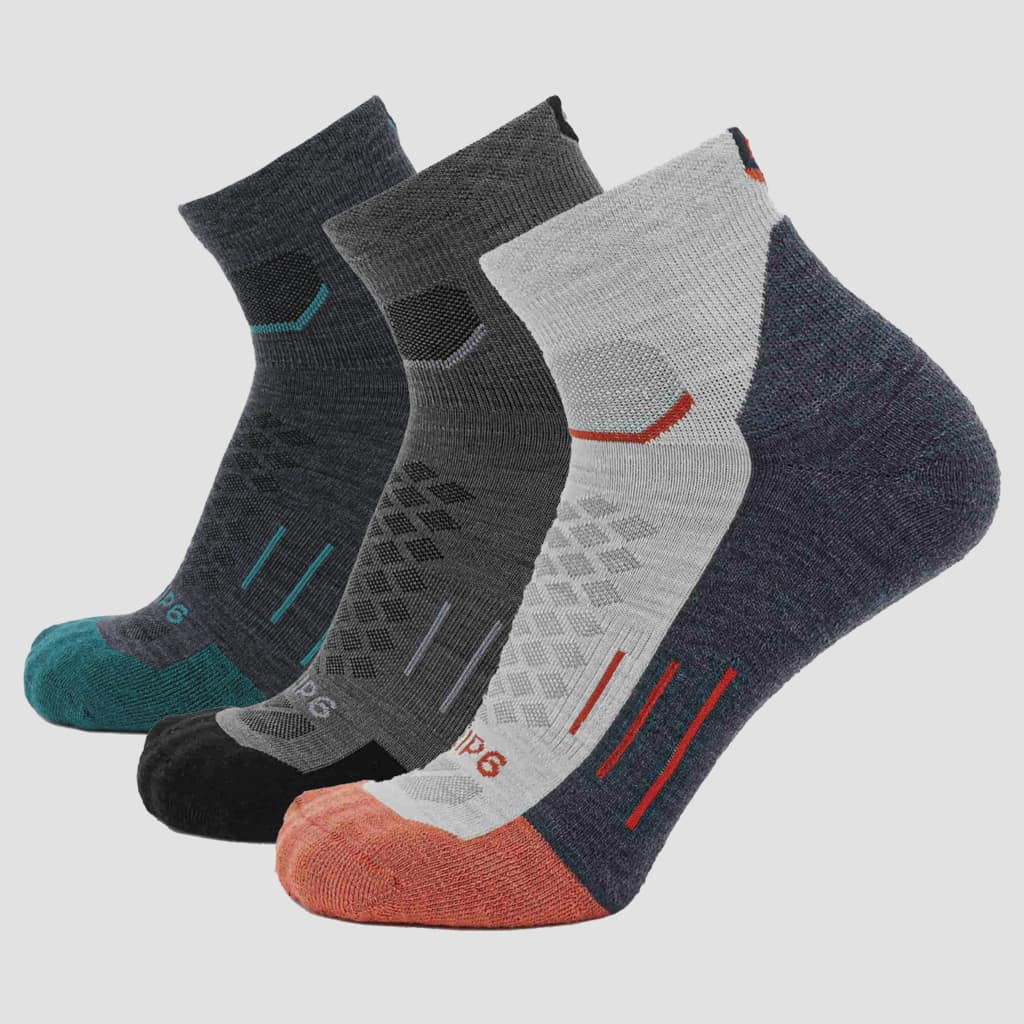In the last year, COVID has reminded all of us why a life outdoors is more than just good for the soul. New generations are discovering that nature often has answers that modern society does not. We need space, we need clean air, we need exercise, and it needs to be accessible. And the Disc Golf World Championship in Ogden, Utah, provides exactly that.
Four years ago, GRIP6 got involved in the world of disc golf. To many, that seemed like a paradigm shift for the GRIP6 brand, “But for those that know us, it’s feels right at home,” said BJ Minson, founder of GRIP6. “It’s equal parts science and sport, and more than anything, it gets you outside.” It doesn’t hurt either that the sport has seen meteoric growth in the last 5 years.
Utah is hosting the Disc Golf World Championships in June. If you didn’t already know that, you’re not alone. But don’t make the mistake of thinking that just because you didn’t know about it, it isn’t popular. The event sold out almost instantly and is expected to bring in $2 million in revenue to the Ogden economy. “We have over 70 professionals on a waiting list who want to play and they can’t, we just don’t have room for them in the event” Says Jade Sewell, the tournaments director. “It just keeps getting more popular every year, and I’ve been doing this for a while”.
So why does it still feel like a secret?

“Disc Golf is a little bit like the electric car,” said Kevin Rogers, a partner at GRIP6, the title sponsor of the event. “Even though it’s always been a good idea, they were so dorky for 20 years that few people were willing to drive one in public. Then one day, Elon Musk comes along and all the sudden, electric cars are cool. Now you hear people bragging about how they knew someone back in ’98 that owned an EV1.”
For decades, disc golf has occupied popular culture in jest only. From Seinfeld to the Simpsons, The Office to Parks and Rec, disc golf has quietly endured a steady dose of mostly good-natured ribbing for more than 45 years. Arguably the best example in sports that “any press is good press,” the media’s attempts to hold it down just made it more relevant. “It’s created what I call the little brother effect,” Rogers said, “where it essentially becomes the relentless underdog that won’t quit.” This phenomenon has created a culture of players who are passionate about promoting the game—and the scale of their success might surprise you.
Matt Kreuger, a software engineer, disc golfer, and co-creator of the popular app UDisc jumped on a call to talk statistics. For those who don’t know, UDisc is a scoring and mapping app that allows players to track where and how they played, along with GPS course mapping tools, conditions, and driving directions. Matt shared some statistics with us that were a little hard to believe, so much so that we took the time to research them ourselves, and believe it or not, they check out.
(You can hear Matt feverishly clicking away at his keyboard before he begins.) “There were over 50 million rounds of disc golf played in the US in 2020. That was on 8,296 different disc golf courses.”

We did the math, that’s an average of 165.92 courses per state. Utah obviously doesn’t have that many, but we’re not as far off as you’d think at 108 – good enough for 31st in the country.
Matt continued, “An estimated five million disc golfers play at least one round per year, and that is a conservative estimate. Another five million have played before, but do not play every year” he said. “Perhaps the most impressive stat was the 3.5 courses installed per day in 2020, and 91% of those courses are free to play.” This statistic covers disc golf globally, but the majority of courses were created in the U.S.
“That’s something that traditional golf just cannot compete with.” Says Jade Sewell, course developer and tournament director of the upcoming World Championships. “Traditional golf has a much steeper financial barrier to entry that can be prohibitive for new generations of players.”
Rogers agrees.
“I was a traditional golfer first” he says, “somewhere between the time and the money I lost interest.” [disc golf generally plays faster, with 9 holes taking between 40-60 min.] He continued, “It’s not that the game wasn’t fun, though, that’s not disputed. I just couldn’t justify its existence in my life any longer. The cost and time commitment were just too great.”
Kevin isn’t alone here. With the exception of 2020 where all forms of golf saw increased participation, traditional golf has been in steady decline since 2003. According to Dr. John L. Crompton with the National Recreation and Park Association (NRPA) there were “6.8 million fewer [ball] golfers in 2018 compared to 2003 — a loss of 22 percent. This resulted in a net reduction of 1,243 18-hole courses between 2005 and 2018”. The decline is attributed to the “high cost of playing, difficulty of courses, and the game’s incompatibility with contemporary lifestyles.”

“On top of that” Rogers says, “ball golf courses are thirsty. If current water trends continue in the American West, golf may end up in the crosshairs. I don’t see a scenario where we don’t see more courses shuttered in the name of water conservation, especially public courses.”
The Disc Golf World Championships take place over three days, on two neighboring courses in Ogden, Utah. Two of the three days are at The Fort, Weber County’s disc golf crown jewel and Jade Sewell’s home away from home at Fort Buenaventura.
“The Fort has grass on about 5% of the course” Jade says, “the rest of it weaves through dense deciduous trees.” An architect by trade, Sewell is sensitive to the sustainability inherent in his design. The fairways have been covered in wood chips recycled from agricultural uses and from mulched trees from park maintenance projects. “This land is essentially native,” Jade says. “We use very little water.”
The other venue is Mulligans Creekside Golf Course where an 18-hole disc golf course has been installed alongside the traditional golf course for several years. Mulligans has been a model of innovation in the golf world, and has managed to remain profitable during the recent decline of golf. When they were approached by Sewell with an opportunity to partner with the disc golf community, they jumped on it. “Our course is privately owned, we don’t receive any subsidies to make this work” said Kip Vandyke, Mulligans Golf Pro. Mulligans is not free for disc golfers, it’s part of the 9% of courses in the US that are pay-to-play. If you’re thinking to yourself, “how many people will actually pay to play disc golf?” you might be shocked to learn that at times, disc golf makes up more than 50% of the rounds played at Mulligans in a day.
“That number doesn’t surprise me at all” Rogers says. “There is a misconception that disc golf is all long hair and sandals. That may have been true 20 years ago, but not anymore. Today’s competitive players have no issues paying to play a nice course. They have the money.” In fact, the sport’s top player, Paul McBeth, signed a $10 million sponsorship contract in early 2021 to represent disc manufacturer Discraft through 2031. To put that into perspective, that’s one million per year, which is more than the median salary of an NFL athlete.

Those kinds of numbers are generating a lot of interest from new players, new sponsors, and increased media coverage. In Fall 2020 the Disc Golf Pro Tour Championship was covered by ESPN for the fist time in the sport’s history. The media landscape in disc golf has been rapidly evolving for the last 5 years, starting with Jonathan Gomez, a business savvy Texan who formed Jomez Productions, known on YouTube as JomezPro. (Texas has more disc golf courses than any other state in the nation, at 566.) Gomez began filming disc golf in 2012, almost by accident. Today, JomezPro produces weekly content for their prolific YouTube channel which now has over 118 million views and almost 300,000 subscribers.
Their content is so well done that ESPN didn’t even send a film crew to the Pro Tour Championship last fall—they just aired the footage that Jonathan and his team produced.
“People involved in the game knew it was bigger than mainstream media was giving it credit for,” Rogers said. “Jonathan should be given credit for making that leap before the rest of the world was willing to. It was a bold move. Those kinds of risks are what separates innovators from imitators.”
Spectator tickets for the Disc Golf World Championships have long since been sold out, but you can watch it online for free on YouTube on the JomezPro Channel. Each round is filmed, edited, and posted the next day. Coverage will begin on Wednesday, June 23rd.
Afterwards, you can take your family to the nearest disc golf course to try it out for yourself. With 108 of them in the state, it shouldn’t be too far away. “This is the Golden Age of disc golf” Rogers says. “Just being a part of that has been amazing.”







Leave a comment
All comments are moderated before being published.
This site is protected by hCaptcha and the hCaptcha Privacy Policy and Terms of Service apply.